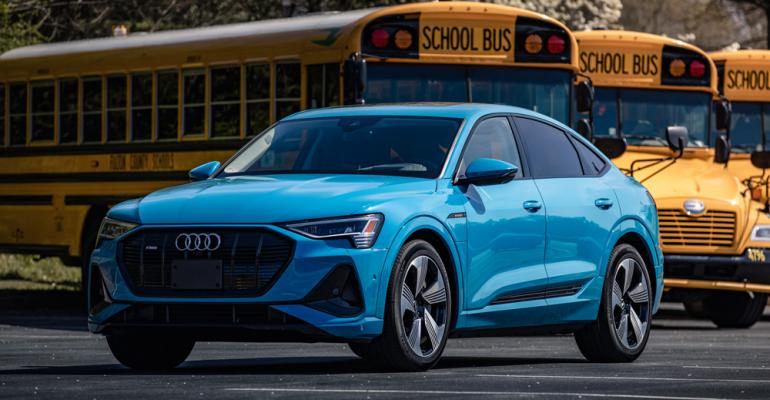School buses are a safe way to transport kids to and from their places of learning. In fact, the National Highway Traffic Safety Admin. calls school buses the “safest vehicle(s) on the road” and says students are about 70 times more likely to arrive at school safely if they take a school bus instead of a car.
But there are moments along the bus route where bad things can happen.
On average, about five children die each year while actually on a school bus, but there are 25,000 injuries and 100 fatalities annually in school zones and at school bus stops in the U.S. These are the numbers that a new partnership between Audi of America, the Blue Bird bus company and a school district in Georgia, among others, are trying to bring down.
The idea expands the use of the cellular vehicle-to-everything (C-V2X) technology that Audi has been working on for years with Qualcomm and Commsignia. Last year, Audi tested C-V2X technology at construction sites in Virginia, finding ways to get the car to notify the driver alerts are coming in from the construction signs or workers.
In Georgia, Audi and its partners installs equipment in both a school bus and in school zone speed-limit signs to produce visual and audio alerts in a test Audi vehicle, in this case a 2021 Audi e-tron Sportback electric SUV.
From the signs, signals are sent when the nearby school is actively welcoming or releasing students. From the buses (well, just one test bus, for now) both LTE and 5G signals are tested when the driver stops to pick up or drop off kids. On a normal bus, loading or unloading signals often are purely visual: flashing red or yellow lights and a folding stop sign on the bus itself.
On the test bus, when these standard warnings are activated and the bus’s “stop arm” (a physical barrier controlled by the driver that only gets raised when there’s no oncoming, moving traffic) is in use, the C-V2X-equipped bus automatically sends out a signal to the nearby e-tron (pictured, below). The driver does not need to take any special steps to trigger the notification.
The Fulton County School System is one of Georgia's largest school districts with a fleet of 930 buses that move 78,000 students to and from school each day. Having widespread technology such as the C-V2X signals would make Trey Stow, the county’s director of transportation operations, feel a lot better about the students for whom he’s responsible.
“I'm not worried about our students once we get them on the bus,” he says. “Our problem is getting those students on the bus and off the bus once they’re in that area, what we call the danger zone around the school bus.”
As with the Virginia road-construction test, Audi is not yet ready to say if or when its production vehicles will be able to receive messages from school buses. The automaker has offered Traffic Light Information (TLI) in its vehicles since the 2017 model year. This vehicle-to-infrastructure technology adds a countdown timer in the car so drivers know when the stop light will turn green.

Currently there are about 21,000 connected traffic signals in over 30 metro areas in the U.S., says Pom Malhotra, Audi of America senior director of connected services.
“The thing that we’ve learned most from TLI is that early alerts change driver behavior, and when you get information about a traffic signal that’s going to be red by the time you get to the intersection, how you approach that intersection is different,” he says.
Audi likely will expand its C-V2X projects thanks to a November 2020 ruling by the Federal Communications Commission that, for the first time, allocated part of the 5.9 GHz cellular band for C-V2X applications.
Audi is saying the school bus project will “influence next-generation vehicle development,” and Malhotra is bullish on this kind of safety technology over the next decade.
“There are 100,000 schools in the U.S., and it is very likely that as this technology proliferates that all of them, say by 2030, will probably be equipped with technologies like this,” he says.





